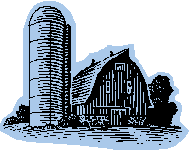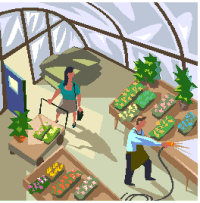Send comments and suggestions to:
Mary Sobba, Agriculture Business Specialist
101 N. Jefferson St., Rm 304
Mexico, MO 65265
(573) 581-3231
sobbam@missouri.edu
To send a message to an author, click on the author's name at the end of the article.
This Month in Ag Connection | Ag Connection - Other Issues Online
Sudden Death Syndrome (SDS) is a disease that often strikes portions of fields with the highest yield potential. SDS was first observed in Arkansas in 1971 and now is found in most major soybean producing areas. The impact of SDS on soybean yield can be devastating. Losses from whole individual fields have been reported as high as 40%, while affected areas were reported to have yield losses of up to 80%.

SDS management options include avoiding or reducing soil compaction, improving soil drainage in fields where SDS problems occur, planting fields with a history of SDS later in the spring, planting cyst nematode resistant varieties, and planting SDS resistant varieties.
SDS resistant varieties are very important to a SDS management program. Keep in mind that no variety is completely resistant to SDS. However, there are varieties that perform very well in severe SDS environments and this is expressed as less foliar symptoms than fully susceptible varieties. The severity of the disease on resistant varieties greatly depends on the weather and the specific conditions of each field.
Iowa State University has released a new publication titled Sudden Death Syndrome-Resistant Soybean Varieties for Iowa - PM 3009. This publication is available as a free download at http://www.extension.iastate.edu/CropNews/2011/. This publication lists over 300 soybean varieties resistant to SDS in maturity groups I, II, and III. The varieties results in the publication were submitted by seed companies and are marketed as SDS resistant by the companies. Different seed companies evaluate their varieties under different conditions and locations and may use slightly different criteria. This could result in ratings that may or may not be comparable to ratings of other varieties from other companies.
Another good source for information on SDS resistant soybean varieties is the Soybean Sudden Death Syndrome Research project at Southern Illinois University (SIU). Their website reports the results of SDS screening for 800 varieties in 2010 at SIU at Carbondale for maturity groups I thru maturity group V. The results were produced at SIU and provides variety to variety comparisons at the same location using the same criteria. The 2010 results as well as results from 1999 thru 2009 are available at this site: http://soybean.siuc.edu/.
SIU calculates a disease index for each variety evaluated. The SDS disease index is calculated as a product of disease incidence and disease severity. It reports the foliar disease index and the relative disease index. The relative disease index compares each entry to a susceptible check appropriate for each maturity group.
Remember, there are no varieties completely resistant to SDS. SDS resistance does not ensure 100 percent control of the disease, but often results only in less foliar symptoms than fully susceptible varieties. The severity of the disease on resistant varieties depends greatly on the weather and specific conditions of the field.
Source: Wayne Crook, MU Extension Agronomy Specialist
This Month in Ag Connection | Ag Connection - Other Issues Online
Many farmers only hire part-time employees or hire help for special projects. Keeping current on labor tax regulations can be especially difficult for these farmers. The following is basic labor tax information agricultural producers should know.
The $150 or the $2,500 Test for Withholding Social Security and Medicare:
Wages paid during the year for farm work are subject to Social Security and Medicare taxes and income tax withholding if either of the following two tests is met:
- You pay wages to an employee totaling $150 or more for the year for farm work, or
- The total wages (cash and noncash) paid during the year for farm work to all your employees is $2,500 or more.
Most tax professionals suggest you always withhold labor tax from all non-exempt employees.

Employment of Family Members:
Wages paid to your children under age 18 are exempt from Social Security, Medicare, and income tax withholding. If your child becomes 18 during the year, wages paid following that date are not exempt. Wages paid to your children are included in calculating the $2,500 test referenced earlier.
Payment of Labor Taxes:
As a general rule, labor taxes need to be deposited monthly or semiweekly. If your total Form 943 labor tax for 2009 (the lookback period for 2011) was less than $50,000 – you should deposit your labor taxes monthly. If you meet the requirements for making monthly deposits – the deposit for the liability for a calendar month must be made by the 15th day of the following month. Remember, beginning this year – you must use electronic funds transfer to make all federal tax deposits. Labor tax deposit will no longer be accepted at banks. If you are sure , and I emphasize sure, your 2011 total 943 labor taxes will be less than $2,500 – you can send your total labor tax payment with your timely filed Form 943 "Employer's Annual Tax Return for Agricultural Employees" and avoid the monthly filing requirement.
Wages Paid-in-Kind:
Commodity wages are not considered cash wages and are therefore not subject to Social Security and Medicare taxes or income tax withholding. Several i's must be dotted and t's crossed in order to insure commodity wages are not reclassified by the IRS as cash wages. Work with a tax specialist if you desire to utilize commodity wages in your employees' compensation package.
In Summary:
As a general rule, Social Security and Medicare must be withheld and matched on wages paid to employees of your business. Additionally, wages subject to Social Security and Medicare taxes are also subject to income tax withholding. A new wrinkle for 2011 is the Social Security withholding on the employee's share is 4.2% instead of 6.2%. The employer's Social Security match remains at 6.2%. This change in the employee's rate is only effective for the 2011 year.
As an agricultural employer you need to have a basic understanding of the labor tax regulations. Withholding labor taxes correctly is the best policy for you and your employees. Explaining the reason for corrective withholdings later in the year can be embarrassing for you and might create financial issues for your employees.
Source: IRS Circular A, "Agricultural Employer's Tax Guide" This publication is available online at: http://www.irs.ustreas.gov/pub/irs-pdf/p51.pdf
Generally, electronic fund transfers are made using the Electronic Federal Tax Payment System (EFTPS). To get more information about EFTPS or to enroll in EFTPS, visit www.eftps.gov or call 1-800-555-4477.
Submitted: Parman R. Green, MU Extension Ag. Business Specialist
This Month in Ag Connection | Ag Connection - Other Issues Online
2010 was the first year Natural Resource Conservation Service (NRCS) offered a conservation practice that targeted horticulture with a system ideal for smaller producers; these producers generally serve local markets.
NRCS obligated $13 million in fiscal year (FY) 2010 for 2,422 seasonal high tunnels in 43 states after receiving nearly 3,000 applications. In Missouri, 159 were obligated for a total of $713,024, compared with the average for participating states of 56 high tunnels and $302,000 requested. Missouri was the fourth highest state, behind Alaska, Minnesota and Wisconsin. A number of high tunnels have been obligated for the counties in the Central Region:

Eligible Missouri producers could receive assistance for up to 2,178 sq ft (5% of an acre) of the cost of materials, ranging from $1.86 to $2.40 per square foot, or on average about $4,000. Many producers elected to build a larger high tunnel, as a traditional unit is 30 by 100 feet. This size unit would typically cost $6 to $8 thousand depending on manufacturer and various specifications.
Assistance for Missouri was offered from two EQIP sources, as part of a $1.2 million initiative targeted to organic growers (or those transitioning to organic) or a $150,000 pilot program for growers preferring production practices not exclusive to organic. Over 80 of the high tunnels were obligated under the organic initiative. For 2011 there have been a few tweaks to some of the 2010 requirements and/or restrictions. Assistance will be provided from both sources again. Interested producers are encouraged to contact their local NRCS office for more details. The enrollment is open for both and the sign up deadline is the same, March 4th.
Side Note!
NRCS offered the seasonal high tunnels (officially called "seasonal high tunnel system for crops") as a conservation practice for the first time in FY 2010 as part of a three-year trial to determine their effectiveness in conserving water, keeping nutrients in the soil, increasing yields, and reducing transport of agricultural pesticides. Seasonal high tunnels are structures made of plastic or metal pipe and covered with plastic or other sheeting. Easy to build, maintain, and move, they provide an energy-efficient way to extend the growing season. Unlike greenhouses, they require no energy, relying on natural sunlight to modify the climate inside to create favorable conditions for growing vegetable and other specialty crops. Funding was under EQIP, or the Environmental Quality Incentive Program.
Source: James Quinn, MU Extension Horticulture Specialist
This Month in Ag Connection | Ag Connection - Other Issues Online
Many business owners feel Uncle Sam delivered some very nice tax packages this year. Unfortunately, like too many of us, Uncle Sam, hasn't actually paid for the presents – he just added them to his "our" charge account. However, unlike you and the rest of us, Uncle Sam has his own "money" printing press.
Two really big packages are definitely worth our discussion: Bonus Depreciation and Estate Tax Exemption amounts.
Bonus depreciation is one of those "stimulus-type tax provisions" that has been available in some form in most years since 2001. For most of that time period, bonus depreciation provided a first-year deduction for half of the cost of qualifying new assets. In general, qualifying assets are business assets with a class life of 20 years or less. This provision has been great for the general farm building industry, since farm buildings are 20 year assets. The new 2010 Tax Relief Act makes bonus depreciation even more attractive by allowing a 100% deduction in the first-year. You read correctly – the ability to elect to expense 100% of qualifying new assets. This provides you with a great tax planning tool.
Now for estate tax provisions – most people had given up on this Congress taking action on this issue prior to the end of 2010. The estate provisions passed were strongly supported and strongly opposed – so they're probably reasonable. However, the new fix is only for a two year period – so you'll have the opportunity to voice your support or opposition for extension or revision for years after 2012.
But for now, estates of decedents that died after December 31, 2009 – the equivalent exemption from estate tax is $5 million and the maximum tax rate is 35 percent. Additionally, most assets passing through an estate will once again be eligible for the step-up in tax basis to fair market value at date of death or the alternative valuation date 6 months following date of death. The exemption is now $1.5 million higher than the exemption available in 2009 and the maximum rate is 10 percent lower.
But you're thinking estate tax was repealed for 2010. For estates of decedents dying in 2010, they have the option to elect to be taxed under the revived estate tax provisions with the $5 million exemption and step-up in basis or be subject to the original repeal provisions. Under the repeal provisions, assets of larger estates don't get a step-up in tax basis to fair market value date of death. So executors of 2010 estates will need to evaluate which provision will best serve the heirs of the estate.
Another good estate tax feature is the carryover provision of unused equivalent exemption amounts between spouses. So if the first spouse to die only uses $3 million of the equivalent exemption, the surviving spouse could possibly have a $7 million equivalent exemption available at their death.
As indicated earlier, the big wrinkle in all of this – is the revived estate tax provisions will sunset (expire) at the end of 2012. Let's hope Congress doesn't wait until the end of December 2012 to provide estate tax laws for estates post 2012.
Source: Parman R. Green, MU Extension Ag. Business Specialist
This Month in Ag Connection | Ag Connection - Other Issues Online
The Show-Me-Select Heifer Development Program (SMS) is a statewide program designed to improve the quality of replacement heifers in Missouri. This University of Missouri educational program outlines specific practices, which have proven to be a benefit in developing a replacement heifer that will have a long and productive life in a Missouri herd.
The SMS program is under the leadership and control of Show-Me-Select Replacement Heifers, Inc. (a not-for-profit organization). To become a member of the organization and have a voice in its operation and direction requires payment of a $5 annual membership fee.
A secondary benefit to membership is the opportunity to participate in the value added opportunities provided by the SMS trademark. These opportunities include the sale of trademarked heifers by private treaty or by participation in sanctioned SMS sales. Many producers have also elected to trademark the heifers they keep in their herd.
Once heifers are worked at pre-breeding, there will be a $2.00 per head data processing fee assessed for any heifers chosen to be nominated as a potential SMS trademarked heifers. Producers will need to work with their veterinarian and local extension livestock specialist to complete the requirements of the program.
Annual producer memberships for the SMS program are $5 and 2011 memberships are currently being taken. For membership applications or for information on the SMS program, contact Gene Schmitz at the MU Extension Center in Warsaw at (660) 438-5012.
Source: Gene Schmitz, MU Extension Livestock Specialist
This Month in Ag Connection | Ag Connection - Other Issues Online
Publishing Information
Ag Connection is published monthly for Northeast and Central areas of Missouri producers and is supported by the University of Missouri Extension, the Missouri Agricultural Experiment Station, and the MU College of Agriculture, Food and Natural Resources. Managing Editor: Mary Sobba.